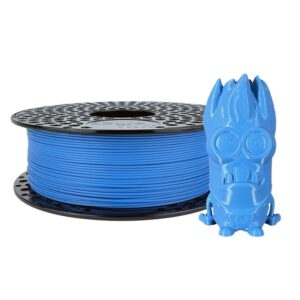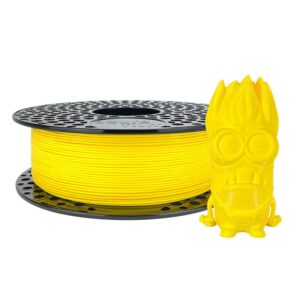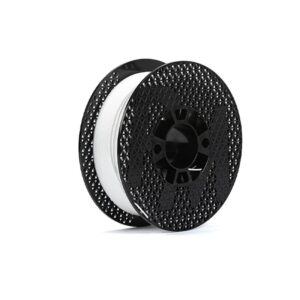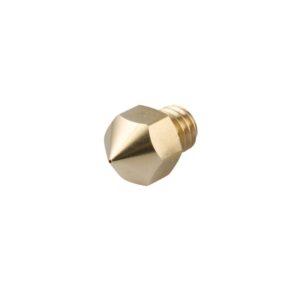Description
Bambu PET‑CF Filament 1.75mm — Cyprus
Bambu PET‑CF blends tough PET with carbon fiber to deliver higher stiffness, excellent strength, and reliable dimensional accuracy. The carbon fiber reinforcement raises hardness and mechanical performance while helping maintain the low warping and low shrinkage typical of PET. As a result, Bambu PET‑CF offers strong heat resistance, a refined soft‑glow surface, and consistent results for load‑bearing parts used in high‑temperature and humid environments.


Low moisture absorption for humid environments
Bambu PET‑CF absorbs very little moisture. Even under saturated conditions, losses in strength and stiffness remain small. Therefore, it is an excellent choice for functional prints that operate in high humidity, where many nylons soften or swell.
Less clumping and stringing
Bambu PETG-CF is improved with a modified formula that specifically addresses the issue of clumping and sticking to nozzle during PETG printing.

High dimensional stability and creep resistance
Thanks to carbon fiber, parts resist creep and hold their shape under load. Warping is low, so mating features align more easily and assemblies fit as designed. In testing, thin beams and long spans retained geometry with tight tolerances when printed at realistic infill levels.
Exceptional thermal resistance
Bambu PET‑CF maintains form at elevated temperatures. Specimens subjected to 70 °C and 150 °C for 30 minutes showed strong resistance to deformation. In practice, this makes PET‑CF suitable for fixtures near heat sources and for enclosures exposed to warm operating conditions. (Note: PLA deforms near its melting point ~155 °C, so PET‑CF is the better option where heat is present.)

Surface quality and appearance
The carbon fiber content produces a technical, low‑sheen finish that hides layer lines. Parts look clean and professional straight off the bed, which reduces post‑processing time on visible components.
Ideal applications in Cyprus
Use Bambu PET‑CF for load‑bearing brackets, jigs, fixtures, precision housings, and mechanical assemblies. It performs well in warm shops, coastal humidity, and light outdoor exposure. Compared with PETG‑CF, PET‑CF contains more carbon fiber and delivers higher strength and heat resistance. Compared with PA‑CF (nylon‑CF), PET‑CF absorbs less moisture, so dimensions remain more stable over time.
Printing setup
– 0.6 mm Hardened Steel Nozzle (Recommended)
– 0.4 mm / 0.8 mm Hardened Steel Nozzle (Capable)
– Enclosed printer (Recommended)
– Open frame printer (Capable)*
-AMS NOT compatible
*Layer bonding of some prints may become low due to overcooling.
Drying, storage, and handling
Dry before printing: 80 °C for 8–12 hours. PET‑CF is sensitive to humidity, so store spools in an airtight container with desiccant and keep printing humidity below 20% RH. During long prints, in‑use dry boxes help maintain properties and surface quality.
Bambu PET-CF
Loading Weight: 1 kg

The test models have a span of 220 mm and a thickness of 3 mm in unloaded state.
Accessory compatibility
- Build plate: Cool Plate SuperTack, Smooth PEI, Textured PEI
- Hotend: Hardened steel 0.4 / 0.6 mm (recommended) / 0.8 mm
- Not recommended: Stainless steel nozzles; 0.2 mm nozzles
- Adhesion: Glue stick, Magigoo; avoid liquid glue on some plates
Frequently Asked Questions
What is the difference between PET-CF and PETG-CF?
The primary difference between PET-CF and PETG-CF lies in their base material. PETG-CF is a reinforced material made by adding carbon fiber to glycol-modified polyethylene terephthalate (PETG), while PET-CF is to polyethylene terephthalate (PET). The key difference ‘G‘ in PETG stands for glycol. PETG is a glycol-modified version of PET that contains small amounts of glycol as a co-monomer. The addition of glycol to PETG reduces its crystallinity and makes it more transparent. However, it also reduces its strength and stiffness.
The difference in application between PETG-CF and PET-CF?
PETG-CF is a versatile basic material that is suitable for printing everyday items, such as bent, folded, and movable parts, due to its excellent toughness and ease of printing. PET-CF, in contrast, contains a greater amount of carbon fiber and is significantly stronger and more temperature resistant compared to PETG-CF. PET-CF is a professional-grade engineering material that is suitable for use in more complex and demanding environments.
What is PET-CF used for?
Due to its dimensional stability and lower water absorption rate, PET-CF is a better choice than nylon for printing functional parts used in high humidity environments. Also, its high-temperature resistance and low warping make it suitable for printing mechanical assembly parts, such as automotive accessories and fixtures.
| Recommended Printing Settings | |
| Drying Settings (Blast Drying Oven) | 80 °C,8 – 12 h |
| Printing and Keeping Container’s Humidity | < 20% RH (Sealed, with Desiccant) |
| Nozzle Temperature | 260 – 290 °C |
| Bed Temperature (with Glue) | 80 – 100 °C |
| Printing Speed | < 100 mm/s |
| Physical Properties | |
| Density | 1.29 g/cm³ |
| Vicat Softening Temperature | 226 °C |
| Heat Deflection Temperature | 205 °C |
| Melting Temperature | 250 °C |
| Melt Index | 25.3 ± 2.5 g/10 min |
| Mechanical Properties | |
| Tensile Strength | 74 ± 6 MPa |
| Breaking Elongation Rate | 4.5 ± 1.2 % |
| Bending Modulus | 5320 ± 270 MPa |
| Bending Strength | 131 ± 6 MPa |
| Impact Strength | 36.0 ± 2.7 kJ/m² |
What’s in the Box

Filament with Spool*1 & Desiccant*1

Package*1
Link to related products & guides:
Printing Tips
• Drying conditions: 80℃ for 8 hrs. PET-CF is highly sensitive to humidity. To achieve optimal printing performance, it is recommended further drying before use and after storage. For more details, please refer to:Filament drying instructions on WIKI.
• To prevent the material from absorbing moisture, it is recommended to use an airtight storage container with desiccant during printing. For more details, please refer to:Printing tips for Engineering materials on WIKI.







